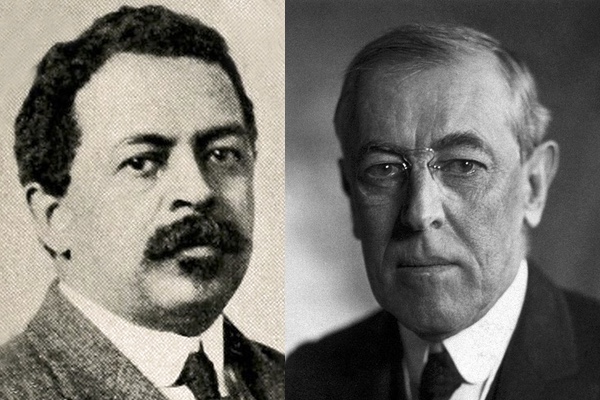The Nasty Face-to-Face Argument that Soured Woodrow Wilson on a Black Civil Rights Leader

A few weeks ago student protesters at the University of Missouri precipitated the removal of their university president and chancellor for their tepid responses to racially charged incidents on campus. The next week students at Princeton tried something much harder—remove a Princeton president who served the university more than a century ago. He happened to go on to be the 28th president of the U.S. as well. Expunging Woodrow Wilson’s legacy at Princeton will take some serious paperwork, not to mention sandblasting. Some students want to change all programs and buildings bearing Wilson’s name. The reason? Wilson was a racist.
When Wilson ran for president in 1912 he met with a delegation of black leaders. This was in an era when African Americans were solidly Republican, the party of Lincoln and antislavery. Among the most prominent black activists to meet with Wilson was William Monroe Trotter, editor of the black newspaper, The Guardian. In assuring Trotter and the others that he would pursue justice for African Americans, Wilson said, “I shall be a Christian gentleman in the White House.” Well, that was the problem. On this and other occasions, he even said, “Our sympathies should also make it easy.” In response black leaders embraced Wilson’s New Freedom campaign, one even claiming after Wilson’s victory, “From the training, high character and Christian sentiment expressed by President-elect Wilson, I see an OPEN DOOR OF HOPE for the negro.” Wilson got more black votes than any previous Democratic candidate.
But this all soured pretty quickly the next year when white southerners in Wilson’s administration began to segregate government agencies. The same black leaders who had campaigned for him became outraged, even more so when Wilson claimed that segregating blacks protected them from discrimination. Trotter and leaders of the NAACP secured two face-to-face meetings with the president. The second ended badly.
Wilson tried to persuade Trotter that segregation was for blacks’ own good and lectured Trotter, “Now, what makes it look like discrimination is that the colored people are in the minority. . . . Any minority looks as if it were discriminated against.” Trotter sort of agreed. Using reasoning that would be employed by the Supreme Court forty years later in Brown v. Board, he tried to get Wilson to see that segregation was discrimination because whites get to decide where, when, and how segregation will be instituted. Delinking segregation from discrimination made no sense to Trotter, nor to most black leaders.
In an exchange that was supposed to last fifteen minutes, the two went back and forth for three-quarters of an hour. Finally, when Trotter said for the second time that blacks had previously hailed Wilson as a second Abraham Lincoln, Wilson exploded. “You are the only American citizen that has ever come into this office who has talked to me with a tone,” Wilson told Trotter. “You have spoiled the whole cause for which you came.” Trotter then referred to America’s Christian principles, but Wilson cut him off. “I expect those who profess to be Christians to come to me in a Christian spirit.” The president then told the delegation that if they ever wanted to talk to him again, they would need to get a different spokesman.
The next year Wilson acquitted himself better, but the memory of that event has been distorted. One of the most famous racist endeavors in American history was the 1915 release of the film Birth of a Nation. The film’s creator, Thomas Dixon, was a Baptist preacher and former Johns Hopkins classmate of Wilson’s. Dixon desperately wanted the president’s endorsement and persuaded Wilson to view the film in the White House. The viewing took place in February 1915. Roughly half-century later a Dixon biographer wrote that after seeing the film Wilson said, “It is like writing history with lightning. And my only regret is that it is all so terribly true.” No one knows where the quote came from, but it worked its way into historical lore and was used again in a history of the Klan in the 1980s.
But Wilson probably never said any such thing. The film was immediately controversial and black leaders called for its censorship. In response Dixon said that both Wilson and U.S. Supreme Court Chief Justice Edward D. White had seen the film and liked it. White responded by threatening to sue Dixon, while Wilson was at first reluctant to issue a statement. Why? Because he wanted to avoid aligning with Trotter, “that unspeakable fellow,” as Wilson referred to him this time around. Trotter had just been arrested for leading a demonstration against the film in Boston. Finally, after some persuasion Wilson allowed his personal assistant Joseph Tumulty to issue a statement saying the president had seen the film but only as a courtesy to an old friend. “At no time,” the statement continued, had the president “expressed his approbation of it.” Moreover, in the 1970s, the only person still alive who had been present at the viewing said Wilson walked out without saying a word.
So was Wilson a racist? Of course he was. He was also a moderate on race, which is about the best we can find among white leaders in the United States in that era. If we had monuments only to racially progressive whites from the early 20th century, the “Progressive Era,” all the statues would fit in the foyer of Wilson College, one of the six residential colleges at Princeton. Wilson was a firm believer in progress, just not too fast when it came to race, which sounds quite a bit like America. Let the debate over him continue.